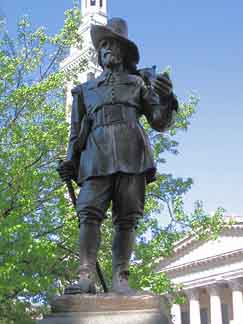Colonial Period
William Pynchon
Founder of the city of Springfield, Pynchon and his family helped build Springfield from a trading post on the outskirts of the colony to a thriving commercial city.
John Pynchon
After his father returned to England, John Pynchon expanded the fur trade in the valley and secured land claims from many Native Americans.
Indentured Servitude in Colonial Springfield
The seventeenth century in the British colonies of North America presented an unprecedented opportunity for laborers. Over half of all immigrants during this period came to the colonies as bonded or indentured servants, contracted to provide labor to a particular master for a fixed period of time in exchange for passage overseas.
Conflict and Cooperation among the First Peoples and European Settlers
European colonization of the Connecticut River Valley set in motion drastic changes for the First Peoples of the region. A clash of cultures - marked by differences in languages, customs, and contrasting world views, including differing conceptions of land ownership and private property - made integration and cooperation between native groups and European colonists nearly impossible.
